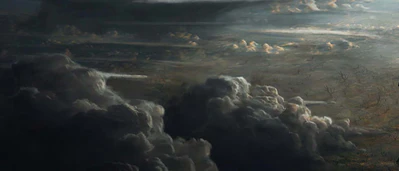
The Virgil System was discovered entirely by chance in 2412. Famed astrophotographer Alaine Viktus was conducting a deep field survey roughly half an astronomical unit past the Vega system’s cometary cloud. Viktus had powered down his survey runabout’s thrusters and ‘gone dark’ to capture a maximum scan resolution. Upon attempting to activate his highly specialized stellar camera, he found it unable to star-lock because of an imperceptible level of spacecraft movement. Further investigation revealed the movement, mere microns from what his IFCS had calculated as standstill, was the result of extreme proximity — within 400 meters — of an uncharted jump point.
General amazement over Viktus’ incredible luck quickly turned to an unequaled passion for expanded space exploration. The K-type main sequence star, quickly named Virgil by Earth spin doctors seeking to instill a sense of regal manifest destiny, was located in a region of space previously thought naturally inaccessible. What’s more, its first planet was the single strongest candidate for terraformation yet discovered. Within ten years, Virgil was a verdant, thriving Human colony and inside of a century it was considered a surefire choice for formal UPE representation. The rapid colonization of Virgil lead to Project: Far Star, the government-funded march ‘outward’ into the area of space now unlocked with Virgil’s discovery.
Then, as rapidly as it began, the situation reversed. The discovery of the Vanduul in 2681 and the onslaught of their increasingly devastating raids brought Far Star and westward galactic expansion to a full stop. Humanity was shocked by the complete fall (and subsequent UEE abandonment) of Orion. Virgil changed into a military outpost overnight, with entire fleets now operating out of the formerly quiet colony. A single jump away from Tiber, where the Empire now hoped to hold the line, Virgil’s fields were adapted to support a massive military buildup.
When Tiber fell, the Navy collapsed in full retreat and was unable to organize a secondary line as the Vanduul pushed relentlessly forward. The Vanduul showed no mercy to the system, slaughtering military personnel and civilians wholesale. Virgil I’s idyllic biosphere was reduced to permanent clouds of ash, and some two hundred years of Human expansion were erased from history. Several transports escaped the carnage, protected by interceptors from the famed Squadron 214. Given the chance to escape the system with the transports they had saved, every member of the squadron chose to return to Virgil I and attempt rescue of more civilians.
In the ensuing years, Virgil had been visited by a number of Reconnaissance in Force missions until a network of surveillance buoys were covertly established by the Empire in 2790 to provide early warning of Vanduul clans entering the system.
There is a famous photograph taken on Virgil I. It shows the charred remnants of an Imperial customs house, wrecked white pillars framing a smoking, coal-black sky. A cracked signboard lies to the right of the image, its original proclamation of “EXPORTS” having had the word DEATH crudely scrawled under it. This image, along with various artists’ interpretations thereof, has appeared on UEE recruiting posters decrying the Vanduul threat for over a century.
Years earlier, the first planet in the Virgil system was the United Planets of Earth’s poster child for terraformation. If ever a world seemed custom-designed to support any easy transition to Human habitation, it was Virgil. The planet’s soil was found to contain super nutrients that would allow imported Human vegetation to thrive quickly. In a matter of years, the planet’s atmosphere had been equalized to Earth standards. Initially covered in swaths of lush tropical forest and seemingly endless plains, Virgil I quickly became both a high-productive ag-world and an exotic tourist destination. With the military buildup, the tenor of Virgil I’s society changed but the natural beauty remained. Antimatter stockpiles and spacecraft repair facilities stood naturally beside the massive trees that largely encircled the planet’s tropical and temperate regions.
Apparently viewing the target as a reward for their hard-fought victory in the Tiber system, the Vanduul ransacked Virgil I with a ferocity previously unseen. Despite the lack of fortifications (few of the Empire’s units had dug in, expecting the fleet at Tiber would be enough to keep the enemy away), the Vanduul pulverized the planet with catastrophic bombing raids that seemed intended more to establish their cruelty than to accomplish any particular strategic goal. Hundreds of thousands of Humans died in the attack, either killed in the bombing raids or churned apart by Harvesters launched onto the still-populated planet.
Today, Virgil is visited rarely. The atmosphere is poisonous, with enough ash kicked up in the bombings to leave the world in a state of permanent nuclear winter. Published reports of UEE spy expeditions have detailed the state of the planet: a harvested wasteland occasionally interspersed with the haunted skeletons of the titanic trees that once inspired awe and wonder. Those who have observed this unique hellscape are forced to ask themselves whether the Vanduul intentionally left them as reminders of the planet’s past.
The Virgil System contains two other worlds and an asteroid field, none of which has been significantly exploited. Virgil II is an uninhabitable smog planet with few worthwhile natural resources. Like Virgil I today, Virgil II’s surface is completely blocked by the natural layer of smog. Military reports have noted that the Vanduul pay Virgil II an especially wide berth, although the reasoning for this is unknown.
A moderate resolution asteroid field separates the second and third planet. Deposits of iron and titanium have been identified here, but never in sufficient quantities to establish mining operations during the system’s Human habitation. The final planet in the system, Virgil III, is an ice giant. Largely unremarkable, Virgil III is a churning ball of water, ammonia and methane (and would have ultimately been used as a source of all three should the system have been further developed).

